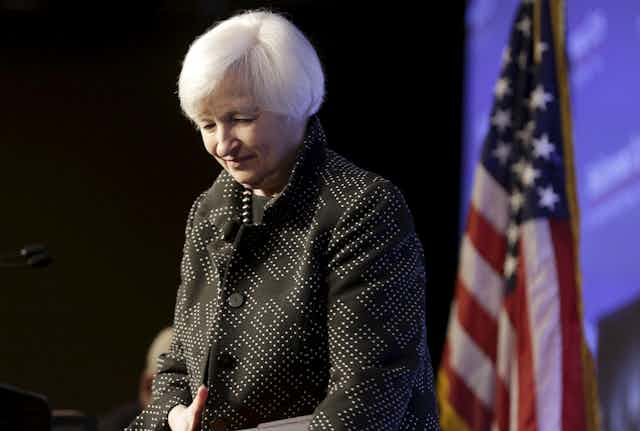On Thursday morning, the Federal Reserve is expected to announce its first increase in US interest rates for nearly a decade.
Since the onset of the global financial crisis, the bellwether “federal funds rate” has been kept at rock bottom levels – between 0 and 0.25%. Given this prolonged easing, Federal Reserve Chair Janet Yellen has faced mounting political pressure over the past year from “inflation hawks” on the Federal Open Market Committee (FOMC).
Of particular importance in limiting Yellen’s options has been the notion of a “Non-accelerating Inflation Rate of Unemployment” or the NAIRU – seen as the unemployment rate at which inflation pressures will once again re-emerge. Even though there exists a strong economic case for keeping interest rates near zero, Yellen took out a political mortgage which has now fallen due. Today, the logic of the NAIRU now dictates a monetary tightening. To maintain her political credibility both on the FOMC and with the wider public, Yellen must begin raising rates.
Yet, while the NAIRU model has a certain logic to it, economic trends give some cause for questioning the danger of renewed inflation – and provide a justification for caution that Yellen is likely to press going forward.
First, as Yellen noted in a recent address to the Economic Club of Washington, the benefits of the US recovery remain unequally distributed – a situation with potentially adverse consequences for demand and which gives pause to warnings of a wage-price spiral.
While unemployment has fallen to 5% in the US, and the economy has been creating an impressive number of new jobs every month – over 200,000 this last November – wages remain flat and labour force participation rates, defined as the ratio between the aggregate labour force and the overall working age population, have yet to recover. More specifically, labour force participation remains at a four-decade low of 62.5% – stuck 4 points below pre-GFC levels.
Secondly, global economic growth remains compromised by the aftereffects of the GFC. The European recovery remains weak, China’s stated growth rates continue to drift downwards, and commodity process remain depressed. This context suggests that the moderate American recovery remains endangered. As Yellen recently noted, “weak net exports… have subtracted more than ½ percentage point, on average, from the annual rate of real GDP growth over the past three quarters.” Should US monetary restraint undermine global growth, this may feed back on US growth – and so a wage-price spiral is less the danger than a self-reinforcing global downturn.
The lag
However, even as Yellen-the-politician has run out of time, Yellen-the-economist retains a few tricks up her sleeve.
The fact that the fed funds rate may be raised matters less than how such increases are justified – and how much discretion Yellen can grab back after this initial hike. For example, in her Economic Club address, Yellen conceded the need to begin raising rates now, and so limit the need for any sudden imposition of greater restraint later. Citing Milton Friedman, Yellen stressed that monetary policy works with a “lag”.
On the one hand, given the possibility of renewed inflation and the potential delays in the effectiveness of monetary policy, this possibility of a lag justifies taking out a degree of insurance in the form of the anticipated increase. On the other hand, the economic logic of the “lag” cuts two ways, requiring caution in tightening as well, lest the Federal Reserve err in the direction of too much restraint, which it cannot reverse later. In this light, Yellen may be seen as laying the foundation for a much greater use of discretionary power than her predecessors.
Indeed, this tendency could be seen in Yellen’s earliest days at the Greenspan Federal Reserve. From 1994 into early 1995, the Greenspan Federal Reserve implemented successive, discrete rate hikes as it shifted from the accommodative stance that had followed the 1990 recession (a series of steps which played a key role in the onset of the Mexican Peso Crisis of 1994-1995).
Frustrated with the recurring nature of these steps, and the overall slack in the economy, Yellen contemplated a dissent against Greenspan. Writing of Yellen’s views in early 1995, Bob Woodward would look back and recall that Yellen “thought that every time she walked into the meetings she heard the same arguments: The economy is hot, we have to raise rates”. From Yellen’s vantage, this real-time focus overlooked the lagged nature of monetary threats – and the fact that cumulative tightenings may prove difficult to reverse. At the time, she thought “it was a good thing they met only every six weeks and not every single week, or the rates would be through the roof. She half wanted to scream out, There’s a lag here, folks! Rate increases take a year or more to have a real impact”.
This wait-and-see attitude has relevance for her stance today. More important than what the Federal Reserve does Thursday morning will be the language that it uses to justify that step – and the extent to which Yellen can use economic logic to claw back some political space. Foreshadowing such a possibility, in her recent December 2 address to the Economic Club, Yellen argued that “economic conditions may, for some time, warrant keeping the target federal funds rate below levels the Committee views as normal in the longer run”. Interest rates may be going up – but going up slowly, as the rule-governed economics of Greenspan yield to the greater discretion of Yellen.

